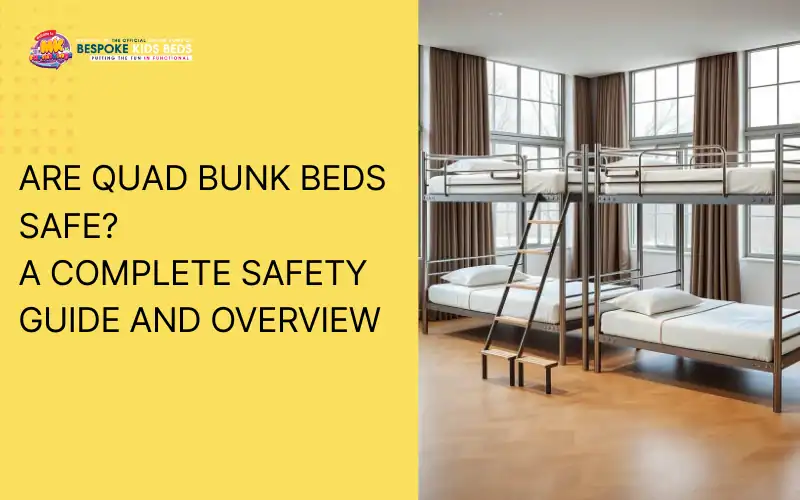
How Much Sleep Do Kids Need?
Babies need 14 to 17 hours, kindergarten aged children need 10 to 13 hours, and teenagers typically need 8 to 10 hours of total sleep.
Enjoy FREE Delivery on All Orders!

Quad bunk beds, also known as 4-sleeper bunk beds, can be a safe and practical choice when they are well-constructed, meet recognised safety standards, and are used responsibly. They’re ideal for shared bedrooms or homes with growing families where space is limited.
As with any bunk bed, safety depends on the details. Potential risks such as falls, structural strain, or overcrowding can occur if the bed lacks proper guardrails, exceeds its weight capacity, or is used by children who are too young for the upper levels. Experts recommend that children under six should not sleep on the top bunks due to higher injury risks.
In this blog, we explain everything you need to know about quad bunk bed safety. You’ll learn the key safety considerations, common risks to watch for, and practical tips to help families make confident, informed decisions when choosing a quad bunk bed.
Quad bunk beds present unique safety concerns due to their increased height, compact structure, and multi-user occupancy. These factors elevate the risk of accidents compared to standard bunk beds. Several core issues demand attention, especially when these beds are used in homes with children or in shared accommodations where supervision varies.
Children under six years old should never use the upper bunks within the quad bunk beds. Their limited coordination and underdeveloped control significantly increase fall risks, which can lead to serious injuries. Official guidelines of bunk beds warn against young children sleeping above the first level. Ignoring age limits can result in head trauma or orthopaedic injuries, which are statistically more frequent among younger users in elevated sleeping environments. Parental supervision and strict access rules are essential to prevent misuse.
Falls from height are a significant risk associated with multi-level bunk beds, particularly those with a quad structure. The top two bunks are notably higher than those in standard twin-level designs, which increases the potential severity of an injury. These falls typically happen in two ways, either during climbing or by rolling out while sleeping. The risk is amplified when guardrails are missing, improperly installed, or don’t meet the minimum height standard of 16 cm. Similarly, climbing hazards increase if ladders are too steep or narrow. To reduce this risk, it’s essential to ensure safety rails are properly installed and of adequate height, and to teach children safe climbing practices.
A quad bunk bed structure demands enhanced stability and precise weight distribution to safely support four sleepers. The risk of structural failure increases significantly if the frame is made from substandard materials or if the joints are poorly reinforced. Overloading a single tier beyond its rated capacity, which is typically 68-90 kg, can lead to a collapse. To prevent this, it’s crucial to adhere to the individual weight limits specified by the manufacturer. Beds made from high-quality hardwood or steel are more likely to maintain their integrity under the load of multiple users.
Accessing and exiting the higher tiers of quad bunk beds presents a significant challenge, especially during emergencies. Narrow or steep ladders can hinder safe movement, making it difficult to climb down quickly in the dark or during a fire evacuation. Unsafe climbing behaviours can also occur when children are rushing or unsupervised. Poor ladder positioning or a lack of clearance near walls can further trap users or delay a swift exit. To mitigate these risks, beds should be installed with safe, angled ladders, and adequate floor space should be ensured around the unit for easy access and egress.
The design of 4-sleeper bunk bed, which prioritises maximising vertical space, often comes at the cost of reduced horizontal clearance. This can limit safe movement around the bed, increasing the risk of users bumping into the frame or nearby furniture. Additionally, headroom in the lower bunks is often minimised, which can lead to users hitting their heads when sitting up or entering the bed. To reduce these risks, it is essential to ensure the bunk bed is placed with adequate clearance on all sides, allowing for safe movement.
Quad bunk beds increase injury risk through more frequent contact with hard surfaces like bed frames, ladders, and guardrails. Collisions, entrapment, and limb injuries are common, especially when children move unpredictably during play or sleep. Limbs can get caught between slats or in open ladder gaps. Beds that meet safety standards often include proper spacing, rounded edges, and secure fasteners to reduce these hazards. Routine supervision and teaching appropriate use behaviours remain essential to injury prevention.
Quad bunk beds are governed by regional and international safety standards designed to minimise injury risks and ensure structural reliability. These guidelines address critical aspects such as frame strength, guardrail height, ladder design, and load capacity. Compliance with recognised certifications is not optional, it is essential for legal sale and safe usage. Beds that meet these standards are more likely to withstand everyday use without structural failure or causing harm.
In the UK, bunk beds, including quadruple configurations, are regulated under the British Standard BS EN 747-1 and BS EN 747-2. These guidelines set out requirements for structural integrity, maximum weight loads, fixed ladder stability, and the presence of safety rails on elevated tiers. The regulations also restrict the sale of such beds for use by children under six on upper bunks. These standards are designed to minimise the risk of accidents, particularly those involving children.
Some of the key safety regulations for high sleeper beds in the UK include:
Globally, the Consumer Product Safety Commission (CPSC) in the United States, ASTM International, and EN 747 in the European Union outline safety rules for bunk beds. All three standards share core requirements, including adequate guardrail height, secured ladder placement, strength under distributed loads, and elimination of entrapment hazards. Differences may exist in specific measurements, for example, CPSC mandates a minimum 5-inch guardrail, while EN standards (6-inch) may vary slightly. Manufacturers producing for multiple markets often align products with the strictest applicable rules set.
Each tier of a quad bunk bed must support a specified weight, often between 68-90 kg. Overloading any bunk can stress the frame, loosen joints, and ultimately lead to collapse. These limits are set based on material strength, design configuration, and safety testing. Labels should clearly display the weight capacity, and users must follow them strictly. Ignoring limits compromises both user safety and structural stability, particularly in upper tiers, which bear dynamic loads from climbing and movement.
Products intended for child or multi-occupant use must be certified by relevant authorities. In the UK, this means compliance with British Standards. In the US, this includes certification under CPSC and ASTM safety standards. Certifications ensure the bed meets requirements for safe spacing, material durability, non-toxic coatings, and design geometry. Products sold without such verification carry a significantly higher risk of failure or injury. Consumers should look for labels or documentation that prove testing and compliance during purchase.
Safety standards explicitly regulate the dimensions and positioning of guardrails and ladders. For example, upper bunks must include guardrails on all sides, with a minimum height above the mattress of usually 16 cm. Ladders must be securely attached, offer handgrips, and maintain consistent spacing between rungs to prevent slipping. Non-compliant ladder designs increase fall risks, especially for children. Manufacturers are required to design access points that facilitate safe movement and prevent misuse.
To safely use a quadruple bunk bed, begin by installing guardrails on every elevated tier, ensuring they are tall, fixed securely, and leave no openings wider than 3.5 inches. Choose a mattress that matches the frame’s exact dimensions, ideally a low-profile mattress to maintain full guardrail coverage.
Routine inspections help detect loose parts, damaged ladders, or worn joints that could compromise structural safety.
Using a properly sized, firm, low-profile mattress ensures guardrails remain effective and prevent fall hazards.
Educating children on safe climbing techniques and respectful bed use minimises accidents and reinforces supervision.
Setting clear behaviour rules and discouraging rough play on or around the bed significantly reduces injury risks.
Installing night lights and cushioned flooring improves nighttime visibility and cushions accidental falls.
Limiting occupancy and respecting weight limits protects the frame from stress damage and prevents structural failure.
Ongoing safety with quad bunk beds depends not only on meeting initial standards but also on continuous attention to usage, supervision, and upkeep. Structural compliance, including guardrail height, ladder integrity, and weight limits, must be maintained throughout the bed’s lifespan, not just at purchase. Regular maintenance checks help identify wear, loosened bolts, or frame fatigue before they become hazards.
Supervision remains essential. Children should be taught to climb safely, avoid horseplay, and respect occupancy rules. Using appropriate mattresses, ensuring night lighting, and keeping the area around the bunk clutter-free further reduces preventable risks. Vigilance is the critical layer that reinforces design safety. Even a compliant bed can become unsafe if misused or neglected.For families seeking high-quality, safety-certified quad bunk beds, MK Furnishings offers durable, thoughtfully designed options that combine style, sturdiness, and practical features for shared or compact bedrooms. Shop with us to ensure your quad bunk bed is both safe and stylish.
Kyle Kane
Owner
Kyle Kane is Co-Owner of MK Furnishings, a family-run business based in UK that specializes in high-quality custom kids’ bunk beds, including triple, double, single, and themed designs. Since launching the company in 2016 alongside his brother-in-law, Kyle has helped deliver and assemble thousands of beds across the UK, Ireland, and beyond. Focused on customer satisfaction, Kyle leads a hardworking team that handles every step from ordering to delivery ensuring a smooth and professional service. His commitment to quality craftsmanship and reliable support has earned MK Furnishings a strong reputation and growing customer base throughout the region.

Babies need 14 to 17 hours, kindergarten aged children need 10 to 13 hours, and teenagers typically need 8 to 10 hours of total sleep.

A mattress should be changed typically anywhere between 6 to 10 years, depending on the mattress type, quality, total usage, and the consistency of the
Fancy £50 off all orders! Enter in 50off to redeem in the coupon code section